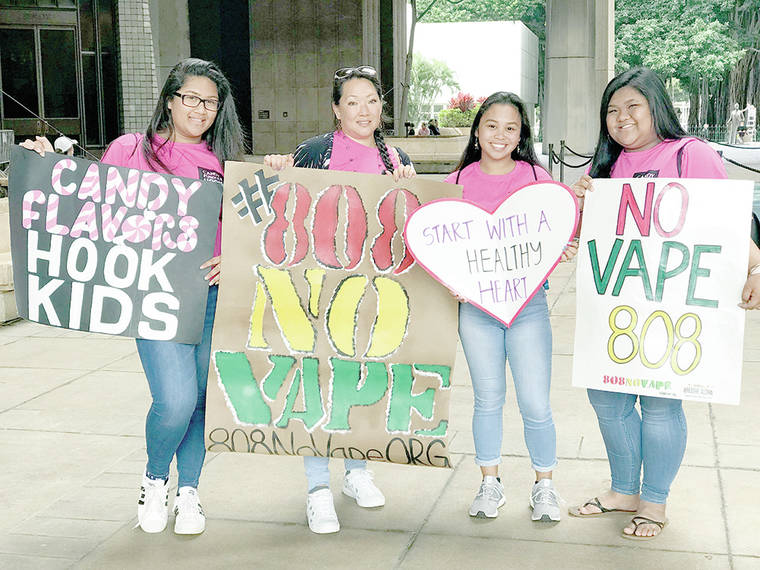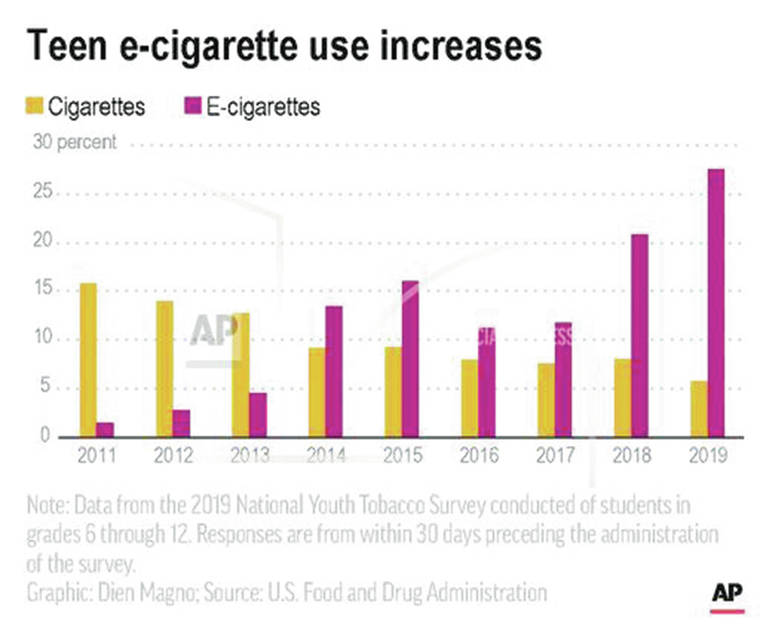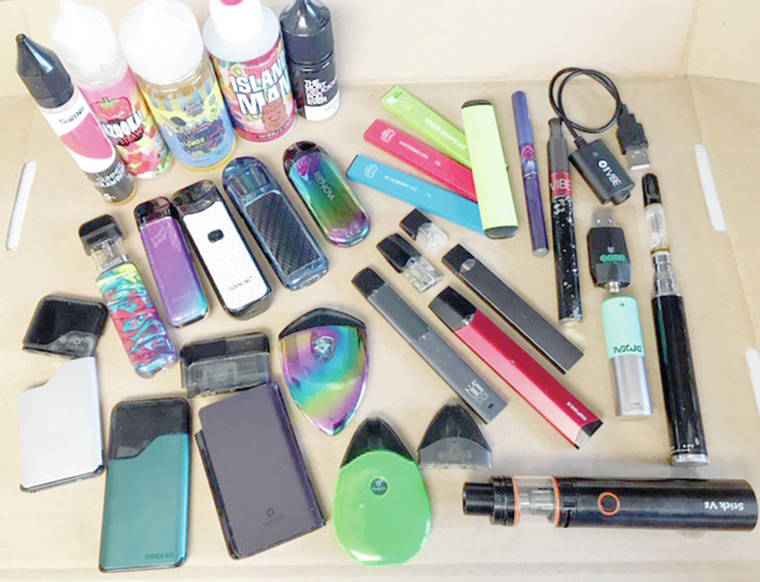KAPA‘A — Kodie Kaina, a freshman at Kapa‘a High School doesn’t use electronic cigarettes anymore, but she started vaping as a sixth-grader when she was 11 years old.
She started vaping for two reasons: “The smoke looked cool, and the juice tasted good.”
Green apple was her favorite flavor. She knew where to go to use the devices, which vaporize flavored liquid that contains nicotine — in bathroom corners with her friends, or sneaking hits off of the device in class.
She stopped because she was caught vaping a few years later, as a 13-year-old in eighth grade. Kaina went through a program taught by Valerie Saiki, Kaua‘i coordinator for the Coalition for a Tobacco-Free Hawai‘i, and decided using e-cigarettes wasn’t a smart lifestyle choice.
“I had to go to Teen Court, and through that I was forced to sit through aunty Val’s presentation, and learn what I was putting into my body,” said Kaina. “My peers are hurting themselves with this product.”
Studies show that using e-cigarettes can lead to lung damage. The American Lung Association lists associated health risks like lung cancer and asthma, and cites a 2016 announcement from the surgeon general concluding that some flavorings contain heavy metals like nickel, tin and lead.
A recent ALA announcement also points to a New England Journal of Medicine study that found people who smoke were 2.4 times more likely to have severe symptoms from COVID-19 compared to those who do not smoke.
The organization said now, when most people are following stay-at-home orders during the COVID-19 pandemic, is the time to teach youth about the hazards of vaping and to find ways to stop smoking. Suggestions include identifying smoking or vaping triggers, signing up for proven support groups, and staying connected with your community.
Several studies, including those by Yale Medicine, show young people are attracted to e-cigarettes because of the candy-like flavors and the convenience of the battery-powered, e-cigarette devices.
Kaua‘i pediatrician Dr. Linda Weiner, who practices in Kalaheo, makes sure to let her patients know of the hazards of e-cigarettes, especially for young people.
“There are multiple risks to vaping — severe and chronic lung disease, addiction to nicotine due to the exceptionally high nicotine levels in the vaping vials, and exposure to multiple unknown toxins in the vaping liquids,” Weiner said.
“In addition, others are being exposed to exhaled vapor containing nicotine and other substances. There is not one advantage to using vaping tobacco products.”
Studies and statistics show that underage vaping (the legal age is 18) is a growing trend in the United States.
Kaina says she’s seen that trend firsthand.
“Underage vaping is one of the biggest problems in our school,” said Kaina. “I used to be one of those kids vaping through my sleeve in the hall. Everyone knows its a problem that should be stopped, but it’s become such a big part of society that it would be hard to just take away.”
Education is the route many schools are taking to combat the problem, said Saiki, who works with youth from multiple schools on the island.
At Chiefess Kamakahelei Middle School, there are consequences lined out for students caught vaping, but school leaders choose to educate students rather than discipline with a heavy hand.
CKMS Acting Principal Jean Morris said the usual procedure is to send students through Saiki’s program because students need to understand the health risks associated with e-cigarettes, and thus an opportunity to make a different choice.
Kaua‘i county Prosecuting Attorney Justin Kollar says students need to see stronger consequences to change the pattern of underage vaping.
“Kids feel like there is no consequence for vaping because the schools haven’t established a unified approach to addressing the problem. The way the law is written now, teachers call the police, who are often dealing with other safety threats,” Kollar said.
“What needs to happen is for the schools to treat this as a disciplinary issue and establish a process for dealing with this short of criminalizing middle schoolers and high schoolers.”
Saiki points out the complexity of the youth vaping issue. There are currently bills in the state Legislature being considered that address flavored vaping products. A multi-angled approach, with support for community programs, is important, she says.
“Prevention and cessation programs need to be adequately funded to provide education and offer resources to help people quit. These strategies have worked to reduce cigarette smoking, and we need to implement them soon to prevent more youth from becoming addicted to nicotine,” Saiki said.
Proposed legislation includes a bill that would establish a tax on e-liquids and electronic-smoking devices that contain e-liquid; require electronic-smoking device and e-liquid wholesalers to obtain a license; require retailers to obtain a tobacco permit; and restrict online sales to those with tobacco permits only.
Kaua‘i County Councilmember Felicia Cowden said curtailing youth vaping, or any behavior that hurts the lungs, is more important than ever in this emergency time of COVID-19.
“Our global community is getting an opportunity for better health practices, and the environment is getting a respite from the environment damage,” Cowden said. “Passing this bill, even on the doorstep of a pandemic, is a step toward a healthier and strong future.”
•••
Stephanie Shinno, features and community reporter, can be reached at 245-0424 or sshinno@thegardenisland.com.




